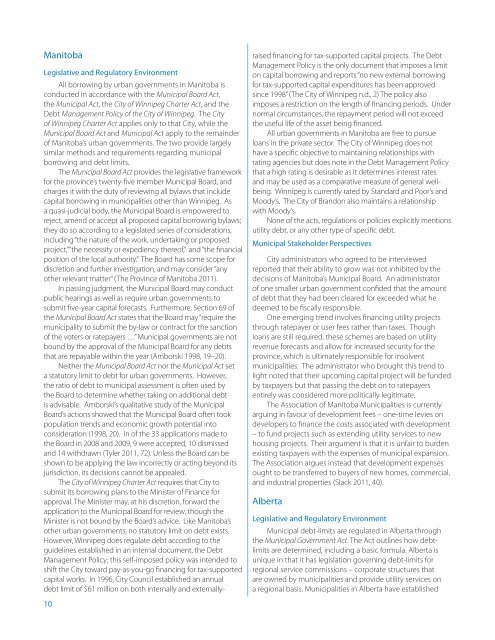Long-term Debt Limits in Saskatchewan - Nipawin
Long-term Debt Limits in Saskatchewan - Nipawin
Long-term Debt Limits in Saskatchewan - Nipawin
You also want an ePaper? Increase the reach of your titles
YUMPU automatically turns print PDFs into web optimized ePapers that Google loves.
Manitoba<br />
Legislative and Regulatory Environment<br />
All borrow<strong>in</strong>g by urban governments <strong>in</strong> Manitoba is<br />
conducted <strong>in</strong> accordance with the Municipal Board Act,<br />
the Municipal Act, the City of W<strong>in</strong>nipeg Charter Act, and the<br />
<strong>Debt</strong> Management Policy of the City of W<strong>in</strong>nipeg. The City<br />
of W<strong>in</strong>nipeg Charter Act applies only to that City, while the<br />
Municipal Board Act and Municipal Act apply to the rema<strong>in</strong>der<br />
of Manitoba’s urban governments. The two provide largely<br />
similar methods and requirements regard<strong>in</strong>g municipal<br />
borrow<strong>in</strong>g and debt limits.<br />
The Municipal Board Act provides the legislative framework<br />
for the prov<strong>in</strong>ce’s twenty-five member Municipal Board, and<br />
charges it with the duty of review<strong>in</strong>g all bylaws that <strong>in</strong>clude<br />
capital borrow<strong>in</strong>g <strong>in</strong> municipalities other than W<strong>in</strong>nipeg. As<br />
a quasi-judicial body, the Municipal Board is empowered to<br />
reject, amend or accept all proposed capital borrow<strong>in</strong>g bylaws;<br />
they do so accord<strong>in</strong>g to a legislated series of considerations,<br />
<strong>in</strong>clud<strong>in</strong>g “the nature of the work, undertak<strong>in</strong>g or proposed<br />
project,” “the necessity or expediency thereof,” and “the f<strong>in</strong>ancial<br />
position of the local authority.” The Board has some scope for<br />
discretion and further <strong>in</strong>vestigation, and may consider “any<br />
other relevant matter” (The Prov<strong>in</strong>ce of Manitoba 2011).<br />
In pass<strong>in</strong>g judgment, the Municipal Board may conduct<br />
public hear<strong>in</strong>gs as well as require urban governments to<br />
submit five-year capital forecasts. Furthermore, Section 69 of<br />
the Municipal Board Act states that the Board may “require the<br />
municipality to submit the by-law or contract for the sanction<br />
of the voters or ratepayers …” Municipal governments are not<br />
bound by the approval of the Municipal Board for any debts<br />
that are repayable with<strong>in</strong> the year (Amborski 1998, 19–20).<br />
Neither the Municipal Board Act nor the Municipal Act set<br />
a statutory limit to debt for urban governments. However,<br />
the ratio of debt to municipal assessment is often used by<br />
the Board to de<strong>term</strong><strong>in</strong>e whether tak<strong>in</strong>g on additional debt<br />
is advisable. Amborski’s qualitative study of the Municipal<br />
Board’s actions showed that the Municipal Board often took<br />
population trends and economic growth potential <strong>in</strong>to<br />
consideration (1998, 20). In of the 33 applications made to<br />
the Board <strong>in</strong> 2008 and 2009, 9 were accepted, 10 dismissed<br />
and 14 withdrawn (Tyler 2011, 72). Unless the Board can be<br />
shown to be apply<strong>in</strong>g the law <strong>in</strong>correctly or act<strong>in</strong>g beyond its<br />
jurisdiction, its decisions cannot be appealed.<br />
The City of W<strong>in</strong>nipeg Charter Act requires that City to<br />
submit its borrow<strong>in</strong>g plans to the M<strong>in</strong>ister of F<strong>in</strong>ance for<br />
approval. The M<strong>in</strong>ister may, at his discretion, forward the<br />
application to the Municipal Board for review, though the<br />
M<strong>in</strong>ister is not bound by the Board’s advice. Like Manitoba’s<br />
other urban governments, no statutory limit on debt exists.<br />
However, W<strong>in</strong>nipeg does regulate debt accord<strong>in</strong>g to the<br />
guidel<strong>in</strong>es established <strong>in</strong> an <strong>in</strong>ternal document, the <strong>Debt</strong><br />
Management Policy; this self-imposed policy was <strong>in</strong>tended to<br />
shift the City toward pay-as-you-go f<strong>in</strong>anc<strong>in</strong>g for tax-supported<br />
capital works. In 1996, City Council established an annual<br />
debt limit of $61 million on both <strong>in</strong>ternally and externallyraised<br />
f<strong>in</strong>anc<strong>in</strong>g for tax-supported capital projects. The <strong>Debt</strong><br />
Management Policy is the only document that imposes a limit<br />
on capital borrow<strong>in</strong>g and reports “no new external borrow<strong>in</strong>g<br />
for tax-supported capital expenditures has been approved<br />
s<strong>in</strong>ce 1998” (The City of W<strong>in</strong>nipeg n.d., 2) The policy also<br />
imposes a restriction on the length of f<strong>in</strong>anc<strong>in</strong>g periods. Under<br />
normal circumstances, the repayment period will not exceed<br />
the useful life of the asset be<strong>in</strong>g f<strong>in</strong>anced.<br />
All urban governments <strong>in</strong> Manitoba are free to pursue<br />
loans <strong>in</strong> the private sector. The City of W<strong>in</strong>nipeg does not<br />
have a specific objective to ma<strong>in</strong>ta<strong>in</strong><strong>in</strong>g relationships with<br />
rat<strong>in</strong>g agencies but does note <strong>in</strong> the <strong>Debt</strong> Management Policy<br />
that a high rat<strong>in</strong>g is desirable as it de<strong>term</strong><strong>in</strong>es <strong>in</strong>terest rates<br />
and may be used as a comparative measure of general wellbe<strong>in</strong>g.<br />
W<strong>in</strong>nipeg is currently rated by Standard and Poor’s and<br />
Moody’s. The City of Brandon also ma<strong>in</strong>ta<strong>in</strong>s a relationship<br />
with Moody’s.<br />
None of the acts, regulations or policies explicitly mentions<br />
utility debt, or any other type of specific debt.<br />
Municipal Stakeholder Perspectives<br />
City adm<strong>in</strong>istrators who agreed to be <strong>in</strong>terviewed<br />
reported that their ability to grow was not <strong>in</strong>hibited by the<br />
decisions of Manitoba’s Municipal Board. An adm<strong>in</strong>istrator<br />
of one smaller urban government confided that the amount<br />
of debt that they had been cleared for exceeded what he<br />
deemed to be fiscally responsible.<br />
One emerg<strong>in</strong>g trend <strong>in</strong>volves f<strong>in</strong>anc<strong>in</strong>g utility projects<br />
through ratepayer or user fees rather than taxes. Though<br />
loans are still required, these schemes are based on utility<br />
revenue forecasts and allow for <strong>in</strong>creased security for the<br />
prov<strong>in</strong>ce, which is ultimately responsible for <strong>in</strong>solvent<br />
municipalities. The adm<strong>in</strong>istrator who brought this trend to<br />
light noted that their upcom<strong>in</strong>g capital project will be funded<br />
by taxpayers but that pass<strong>in</strong>g the debt on to ratepayers<br />
entirely was considered more politically legitimate.<br />
The Association of Manitoba Municipalities is currently<br />
argu<strong>in</strong>g <strong>in</strong> favour of development fees – one-time levies on<br />
developers to f<strong>in</strong>ance the costs associated with development<br />
– to fund projects such as extend<strong>in</strong>g utility services to new<br />
hous<strong>in</strong>g projects. Their argument is that it is unfair to burden<br />
exist<strong>in</strong>g taxpayers with the expenses of municipal expansion.<br />
The Association argues <strong>in</strong>stead that development expenses<br />
ought to be transferred to buyers of new homes, commercial,<br />
and <strong>in</strong>dustrial properties (Slack 2011, 40).<br />
Alberta<br />
Legislative and Regulatory Environment<br />
Municipal debt-limits are regulated <strong>in</strong> Alberta through<br />
the Municipal Government Act. The Act outl<strong>in</strong>es how debtlimits<br />
are de<strong>term</strong><strong>in</strong>ed, <strong>in</strong>clud<strong>in</strong>g a basic formula. Alberta is<br />
unique <strong>in</strong> that it has legislation govern<strong>in</strong>g debt-limits for<br />
regional service commissions – corporate structures that<br />
are owned by municipalities and provide utility services on<br />
a regional basis. Municipalities <strong>in</strong> Alberta have established<br />
10






